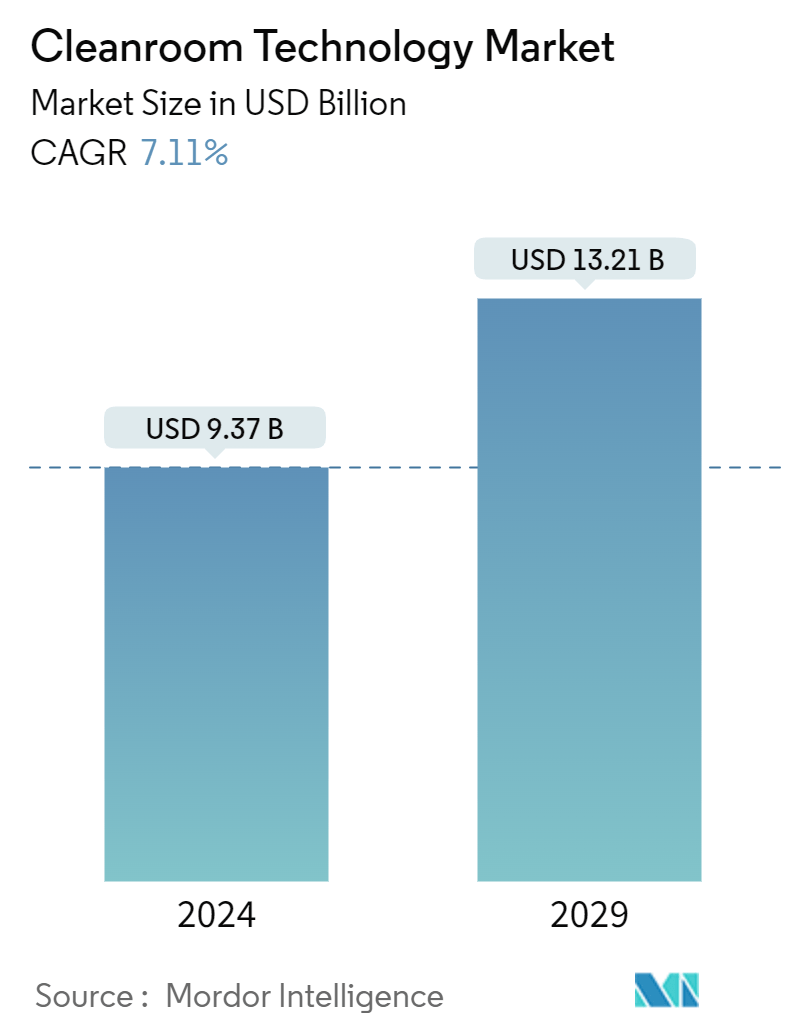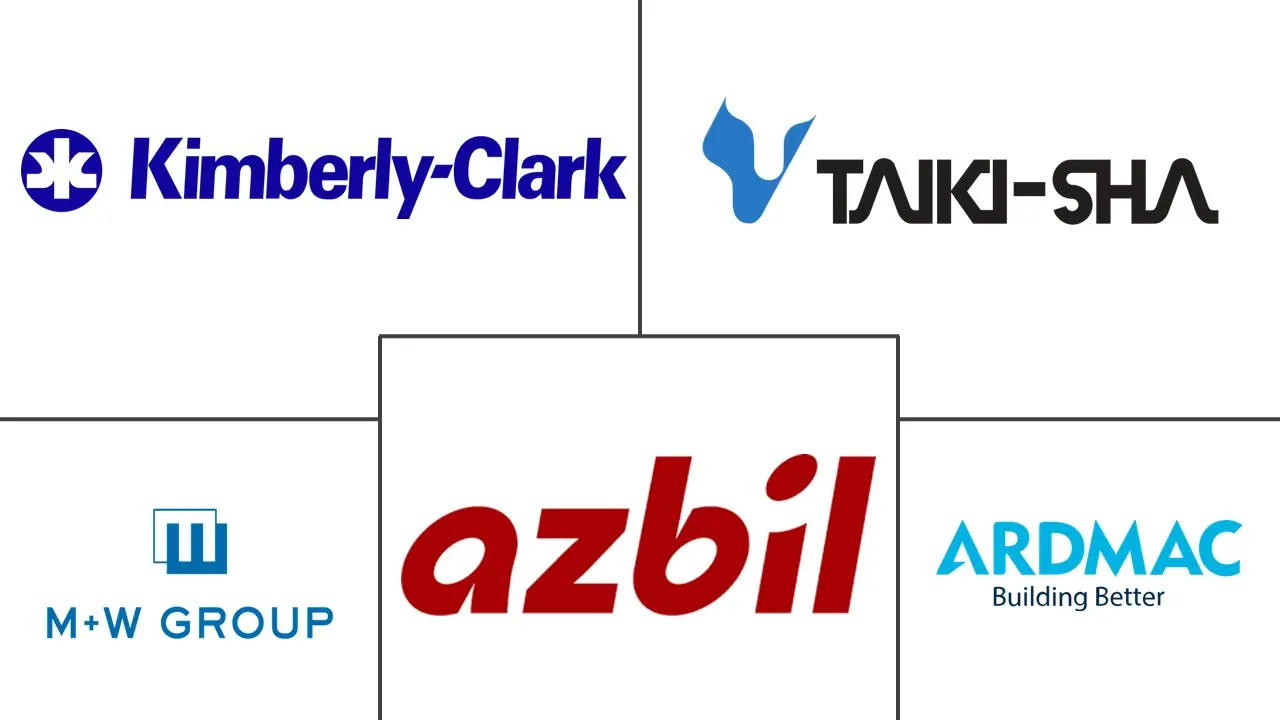Market Size of Cleanroom Technology Industry

| Study Period | 2019 - 2029 |
| Market Size (2024) | USD 9.37 Billion |
| Market Size (2029) | USD 13.21 Billion |
| CAGR (2024 - 2029) | 7.11 % |
| Fastest Growing Market | Asia Pacific |
| Largest Market | North America |
| Market Concentration | Medium |
Major Players
*Disclaimer: Major Players sorted in no particular order |
Cleanroom Technology Market Analysis
The Cleanroom Technology Market size is estimated at USD 9.37 billion in 2024, and is expected to reach USD 13.21 billion by 2029, growing at a CAGR of 7.11% during the forecast period (2024-2029).
- The demand for cleanroom technology grows as quality and safety standards evolve and become more stringent. Cleanrooms offer controlled environments with precise regulation of air quality, particulate levels, temperature, and humidity. They minimize the risk of contamination from airborne particles, microorganisms, and other contaminants that can adversely affect product integrity. Industries such as pharmaceuticals, biotechnology, and electronics rely on cleanrooms to meet the strict quality and safety requirements imposed by regulatory bodies. The increasing focus on quality and safety standards drives the adoption of cleanroom technology to maintain and ensure significant product quality and safety standards.
- The modern, clean room development began during the Second World War to enhance the quality and reliability of instrumentation used in manufacturing tanks, guns, and aircraft. During this time, HEPA filters were also developed to contain the dangerous radioactive, microbial, or chemical contaminants that resulted from experiments into nuclear fission and research into chemical and biological warfare. The evolution of clean rooms gained momentum due to NASA's space travel program in the 1950s and 1960s. During this time, the 'laminar flow' concept was introduced, marking a turning point in clean room technology.
- With the growing demand for electronics, cleanroom technology providers are witnessing increased business. As a result of this, governments from developed and developing nations are significantly working toward securing ample cleanrooms to handle any scarce situation domestically. For instance, the US government officially passed the CHIPS Act in the previous year. Under this act, the US government wanted US companies to build cleanrooms in the United States for semiconductor manufacturing instead of outsourcing to cleanrooms in foreign countries. After introducing this act, foreign semiconductor manufacturers have also been planning new US-based cleanrooms to get US government funding.
- In April 2024, President Biden announced up to USD 6.1 billion preliminary agreement with Micron under the CHIPS and Science Act. This investment will support the construction of two fabs in Clay, New York, and one fab in Idaho, releasing USD 50 billion in private investment by 2030 as the first step toward Micron's investment of up to USD 125 billion across both states over the next two decades to create a leading-edge memory manufacturing ecosystem. Funding will support the construction of the first two fabs of a planned four-fab "megafan" focused on leading-edge DRAM chip production. Each fab will have 600,000 square feet of cleanrooms, totaling 2.4 million square feet of cleanroom space across the four facilities, the most extensive cleanroom space ever announced in the United States and the size of nearly 40 football fields.
- Growing demand for medical instruments and increasing R&D spending in the pharmaceutical industry further propel the market growth. According to IQVIA, the global pharmaceutical market has experienced significant growth in recent years. In 2023, the total global pharmaceutical market was around USD 1.6 trillion. This is an increase of over USD 100 billion compared to the previous year.
- The demand for cleanroom technology grows as quality and safety standards evolve and become more stringent. Cleanrooms offer controlled environments with precise regulation of air quality, particulate levels, temperature, and humidity. They minimize the risk of contamination from airborne particles, microorganisms, and other contaminants that can adversely affect product integrity. Industries such as pharmaceuticals, biotechnology, and electronics rely on cleanrooms to meet the strict quality and safety requirements imposed by regulatory bodies. The increasing focus on quality and safety standards drives the adoption of cleanroom technology to maintain and ensure significant product quality and safety standards.
- For instance, in August 2023, Bosch announced plans to establish a state-of-the-art semiconductor test center for chips and sensors in Malaysia. The facility boasts an expansive area of over 18,000 square meters, housing clean rooms, office spaces, and dedicated R&D laboratories to accommodate up to 400 associates.
- Cleanrooms are gaining popularity in various end-user markets as a controlled environment is necessary for maintaining high-quality products. However, the cost of a cleanroom is not only highly investment-intensive to build, but operational costs can also rely on the number of required air exchanges and filtration efficiency.
- The operation can be extremely costly, as holding the appropriate air quality means the room has to be in constant operation. Energy-efficient operation and continuous adherence to cleanroom standards make a cleanroom one of the most critical infrastructures for manufacturing technology and laboratories. This is anticipated to challenge the market's growth.
Cleanroom Technology Industry Segmentation
A cleanroom is a controlled environment that filters pollutants like airborne microbes, dust, and aerosol particles to deliver the cleanest area possible. In a controlled environment with minimal particulate contamination, specific temperature, humidity, room pressure, and particle and dust count are achieved and maintained using cleanroom equipment, specialized partitions, cleanroom walls, ceilings, and flooring systems. Consumables like apparel, gloves, wipes, vacuum systems, disinfectants, and sanitizers are used.
The cleanroom technology market is segmented by component (type of equipment {cleanroom air showers, HVAC systems, laminar airflow systems, high-efficiency filters, desiccator cabinets, and fan filter units}, type of consumable {apparel, gloves, wipes, vacuum systems, disinfectants, and other type of consumables}), end users (pharmaceutical, biotechnology, medical devices, hospitals, semiconductor manufacturing, and other end users), and geography (North America, Europe, Asia-Pacific, Latin America, Middle East and Africa, and Rest of the World). The market sizes and predictions are provided in terms of value in USD for all the above segments.
| By Component | ||||||||
| ||||||||
|
| By End User | |
| Pharmaceutical | |
| Biotechnology | |
| Medical Devices | |
| Hospitals | |
| Semiconductor Manufacturing | |
| Other End Users |
| By Geography | |
| North America | |
| Europe | |
| Asia | |
| Australia and New Zealand | |
| Latin America | |
| Middle East and Africa |
Cleanroom Technology Market Size Summary
The cleanroom technology market is poised for significant growth, driven by the increasing demand for controlled environments across various industries such as pharmaceuticals, biotechnology, and electronics. These industries rely on cleanrooms to adhere to stringent quality and safety standards, minimizing contamination risks that could compromise product integrity. The evolution of cleanroom technology, which began during World War II and gained momentum with NASA's space programs, has led to advanced systems capable of regulating air quality, temperature, and humidity with precision. The market is further bolstered by the growing need for semiconductor manufacturing, where cleanrooms are essential for producing sensitive microelectronics. The expansion of 5G networks, IoT devices, and AI applications is fueling investments in cleanroom facilities, ensuring the production of high-quality chips.
North America is expected to experience robust growth in the cleanroom technology market, driven by technological advancements, a burgeoning healthcare sector, and stringent regulatory standards. The region's focus on strengthening chip manufacturing capabilities, supported by government initiatives like the CHIPS Act, is set to enhance its market position. The competitive landscape is characterized by intense rivalry among numerous vendors, with key players such as M+W Group GmbH and Azbil Corporation vying for market share. Recent developments, including the launch of innovative cleanroom solutions and strategic partnerships, underscore the dynamic nature of the market. As industries continue to prioritize quality and safety, the demand for cleanroom technology is anticipated to rise, offering substantial growth opportunities in the coming years.
Cleanroom Technology Market Size - Table of Contents
-
1. MARKET INSIGHTS
-
1.1 Market Overview
-
1.2 Industry Attractiveness - Porter's Five Forces Analysis
-
1.2.1 Bargaining Power of Suppliers
-
1.2.2 Bargaining Power of Buyers
-
1.2.3 Threat of New Entrants
-
1.2.4 Threat of Substitutes
-
1.2.5 Degree of Competition
-
-
1.3 Impact of Key Macroeconomic Trends on the Market
-
-
2. MARKET SEGMENTATION
-
2.1 By Component
-
2.1.1 Type of Equipment
-
2.1.1.1 Cleanroom Air Showers
-
2.1.1.2 HVAC Systems
-
2.1.1.3 Laminar Air Flow Systems
-
2.1.1.4 High Efficiency Filters
-
2.1.1.5 Desiccator Cabinets
-
2.1.1.6 Fan Filter Units
-
-
2.1.2 Type of Consumable
-
2.1.2.1 Apparels
-
2.1.2.2 Gloves
-
2.1.2.3 Wipes
-
2.1.2.4 Vacuum Systems
-
2.1.2.5 Disinfectants
-
2.1.2.6 Other Types of Consumables
-
-
-
2.2 By End User
-
2.2.1 Pharmaceutical
-
2.2.2 Biotechnology
-
2.2.3 Medical Devices
-
2.2.4 Hospitals
-
2.2.5 Semiconductor Manufacturing
-
2.2.6 Other End Users
-
-
2.3 By Geography
-
2.3.1 North America
-
2.3.2 Europe
-
2.3.3 Asia
-
2.3.4 Australia and New Zealand
-
2.3.5 Latin America
-
2.3.6 Middle East and Africa
-
-
Cleanroom Technology Market Size FAQs
How big is the Cleanroom Technology Market?
The Cleanroom Technology Market size is expected to reach USD 9.37 billion in 2024 and grow at a CAGR of 7.11% to reach USD 13.21 billion by 2029.
What is the current Cleanroom Technology Market size?
In 2024, the Cleanroom Technology Market size is expected to reach USD 9.37 billion.

